Water Pitcher, St. Mary’s County
From the USS Maryland Silver Service
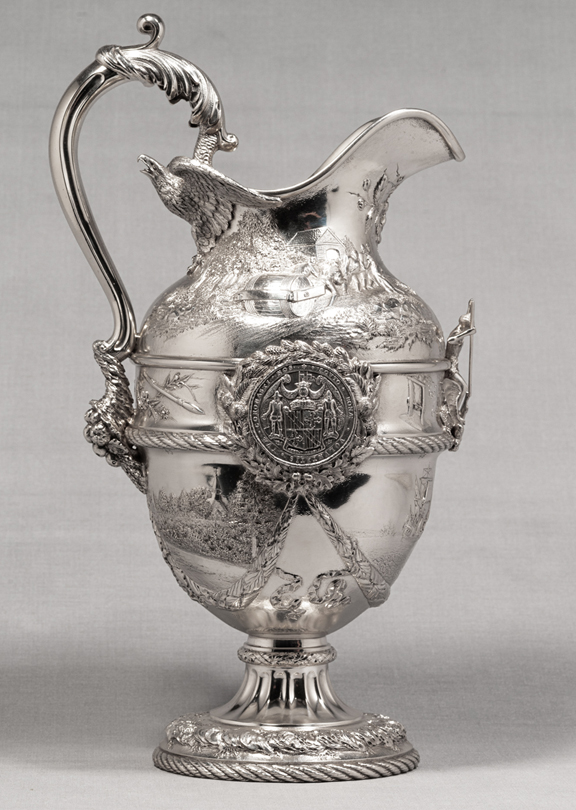
Maker: Samuel Kirk & Sons (1815-1979)
Object: Water Pitcher, St. Mary’s County
Date: 1906
Medium: Sterling Silver
Dimensions: Overall height, 15"; Overall width, 7 1/8"; Diameter of base, 3 1/2"
Accession number(s): MSA SC 1545-0927-1
Saint Mary’s County, Maryland’s first county, is represented by this elaborately decorated water pitcher. The first English settlers landed at St. Clement's Island in the Potomac River on the southwestern side of present-day St. Mary's County in 1634 to establish Lord Baltimore's Maryland. The passengers had set sail on the Ark and the Dove from the Isle of Wight on November 22, 1633. The County was established in 1637 and named in honor of Mary, the mother of Jesus. St. Mary’s City served as the capital of Maryland until 1694 when the capital relocated to Annapolis.
The scenes on the water pitcher commemorate the early history of the county, and each scene is framed by festoons of tobacco leaves. The figure of St. George, the only applied figure in the entire service, was chosen to represent religious tolerance.
Wreaths of native foliage surround the Great Seal and the Cruiser, while a cornucopia at the base of the handle contains native fruits and vegetables. Oyster shells surround the base.
1. Slaves Rolling Hogsheads of Tobacco Along “Rolling Roads” (number 38)
The first tax on Maryland’s tobacco was implemented in 1671. To accommodate the tax, “rowling houses” were built to store the tobacco near the edges of the water for ease of shipment. Dried tobacco leaves were compressed into a hogshead barrel, which usually weighed between 800-1000 pounds. These barrels would then be rolled down a road from the farm to the water along what became known as “Rolling Roads.” This scene depicts enslaved individuals rolling a hogshead to the rowling house, which can be seen in the background.
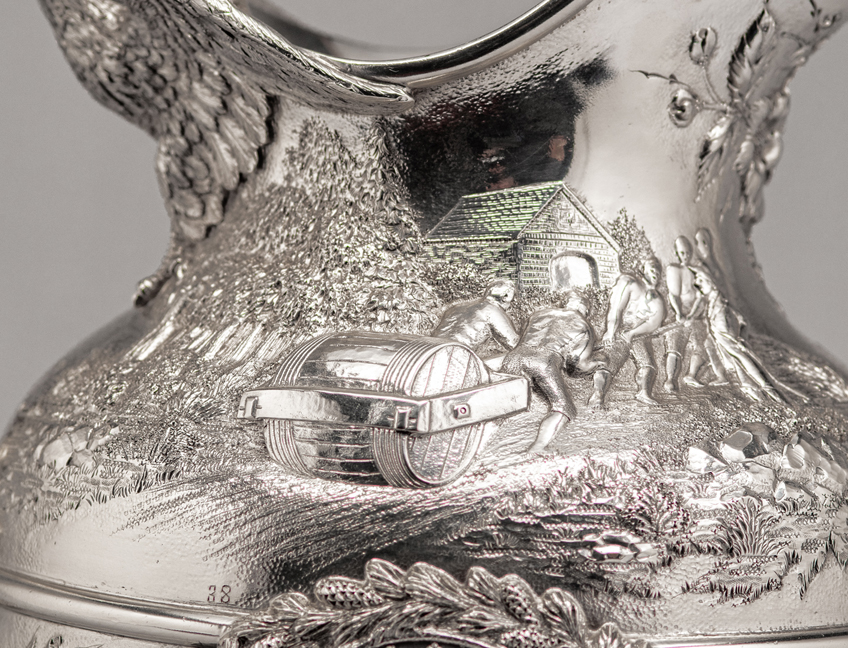
Peregrine Williamson, a jeweler from Baltimore, wanted to have a more durable writing instrument than the typical quill pen. He started testing designs in 1806 and by 1808 felt so confident in his pen he sent some as a gift to President Thomas Jefferson. In 1809, he was granted the first patent for a metallic pen and, in 1835, he was granted a second patent for an improved metallic pen. While Williamson’s original patent was lost in a fire, this depiction is based on one of his early pens held in the collection of the Maryland Center for History and Culture.
The first steel pen is also depicted on pieces from Charles, Somerset, and Wicomico counties.
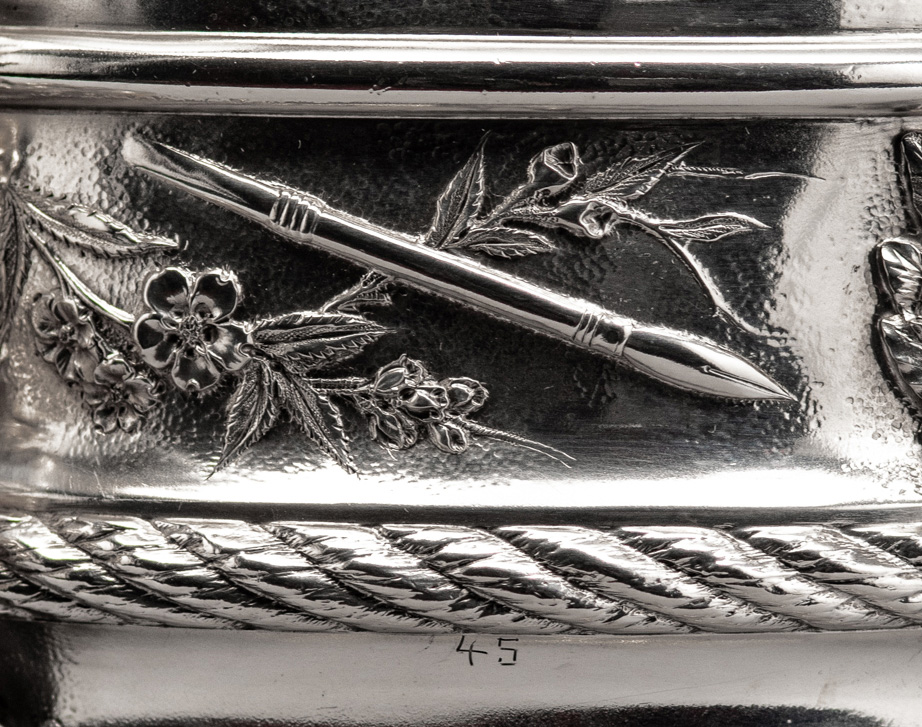
4. The First Telegraph Set (number 46)
After twelve years of design and development, the first telegraph message in the United States was transmitted on above ground poles between Washington D.C. and Baltimore on May 23, 1844. Samuel F.B. Morse sent the message "What hath God wrought” to his partner Alfred Vail.
The original transmitting and receiving sets are now at the Smithsonian Institute and are also depicted on the pieces from Baltimore City and Baltimore, Calvert, Charles, Somerset, and Wicomico counties.
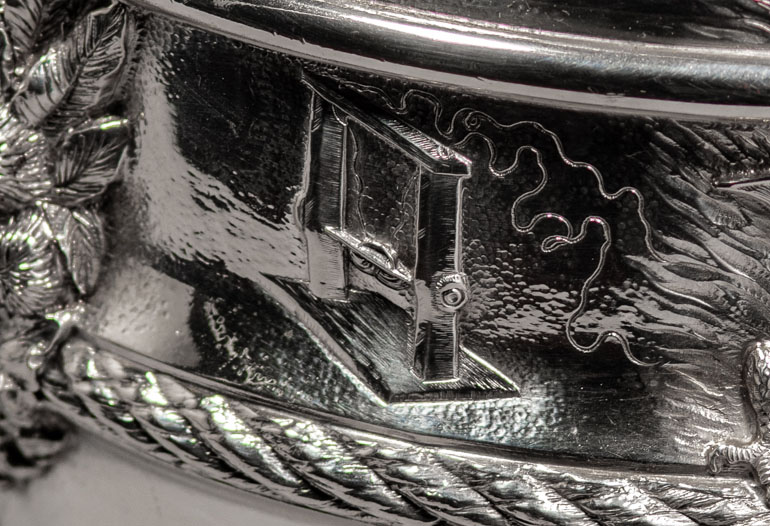
As a colony, Maryland was the first to pass laws on religious tolerance by specifying and protecting the rights of its citizens. “An Act for Church Liberties” in 1638 secured freedom of worship. In 1649, “An Act Concerning Religion'' stated that regardless of Christian denomination, “no person or persons whatsoever within this province… shall from henceforth be in any ways troubled, molested, or discountenanced for or in respect of his or her religion, nor in the free exercise thereof…" These laws did not directly protect the rights of other religious groups. It would not be until 1826 that members of the Jewish faith could hold office in Maryland’s government.
A figure representing St. George slaying a dragon, likely meant to represent Christianity triumphing over persecution, is located on the lip and is symbolic of religious tolerance in Maryland.
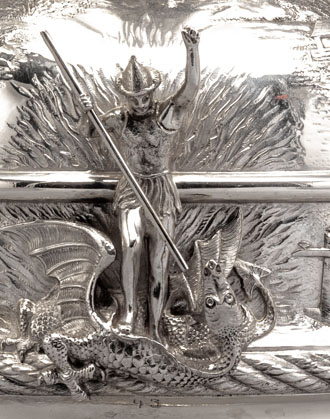
Long before the first European settlers arrived in what is now Maryland, the land had been inhabited for thousands of years by various Native American groups, including the Yaocomaco. They spoke a dialect of the Eastern Algonquian language and interacted with other larger tribal groups, such as the Piscataway and Powhatan.
After the landing of Leonard Calvert and about 140 English colonists, the settlement of St. Mary’s became the first seat of government in the Province of Maryland. St. Mary's, except for two brief intervals, was the capital of Maryland for nearly 60 years.
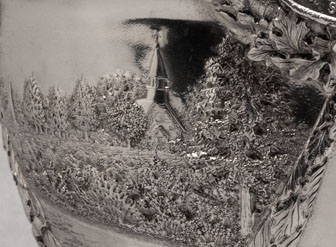
On November 22, 1633, English settlers led by Leonard Calvert set sail on two vessels, the “Ark” and the smaller “Dove” to establish a settlement under a charter from King Charles I. The “Ark” held about 140 colonists and their equipment and supplies while the “Dove” was sent to enable the colonists to have their own ship once “Ark” returned for England. On March 25, 1634 they celebrated their safe arrival at St. Clement’s Island.
The ships then went 27 miles northward on the Potomac and encountered a small village inhabited by the Yaocomaco people. After negotiating a treaty of peaceful coexistence with the Yaocomaco, the colonists named their town St. Mary’s City.
![Settlement at St. Mary’s [landing of the Ark and the Dove]](images/uss_md_41.jpg)
Scenes on the Reverse (left to right, top to bottom):
1. Slave Quarters (number 40)
The first reference to slavery in 1639 was, "An Act for the Liberties of the People," which stated, "that all the inhabitants of this province being christians (slaves excepted) shall have and enjoy all such rights, liberties, immunities, privileges and free customs, within this province, as any natural born subject of England…” In 1664, a law passed by the colonial legislature made slavery into a race-based system in which Africans or people of African descent were enslaved for life and also bound the lives of their children. Additional laws passed in the following decades further dehumanized the enslaved population.
The fortunes amassed from the labor of enslaved workers allowed Maryland’s gentry to dominate colonial politics and propelled some to national prominence.The structures depicted on this portion of the pitcher are those built for the enslaved to live in, based on the quarters located on the Brome estate in Historic St. Mary's City.
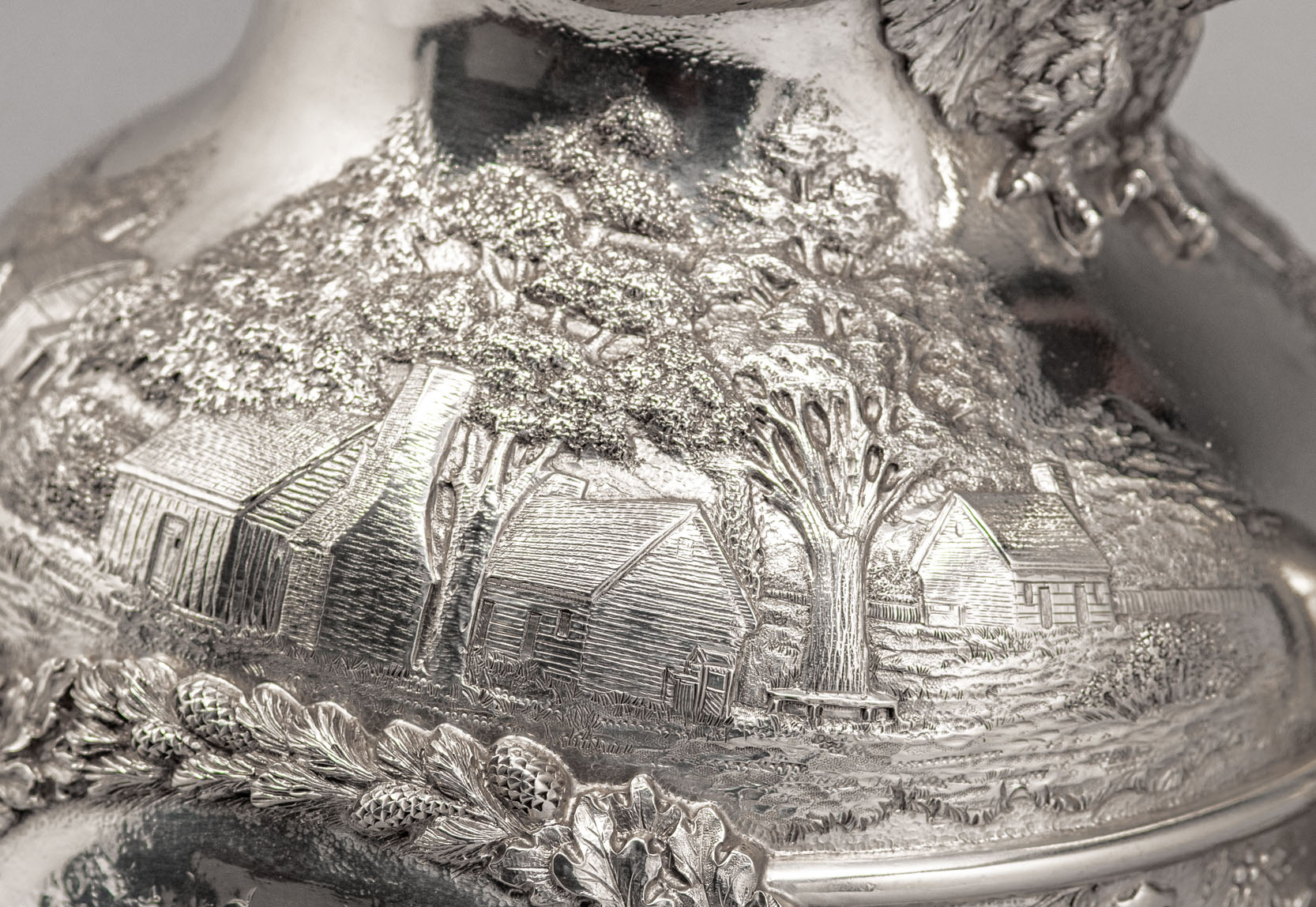
2. The First Telegraph Set (number 46)
The original transmitting and receiving sets are now at the Smithsonian Institute and are also depicted on the pieces from Baltimore City and Baltimore, Calvert, Charles, Somerset, and Wicomico counties.
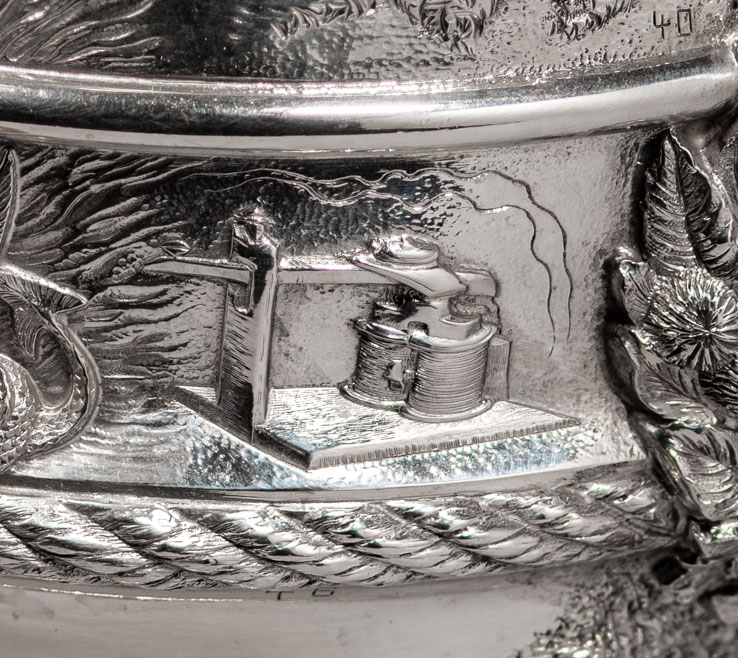
3. USS Maryland Cruiser
4. Cokesbury Bell (number 44)
In 1888, the historic Cokesbury Bell was transferred to Goucher College, then in Baltimore City, and it remained with Goucher College until 1959 when it was presented to the Wesley Theological Seminary in Washington, D.C. The bell is also depicted on the pieces from Somerset, Wicomico, and Charles counties.
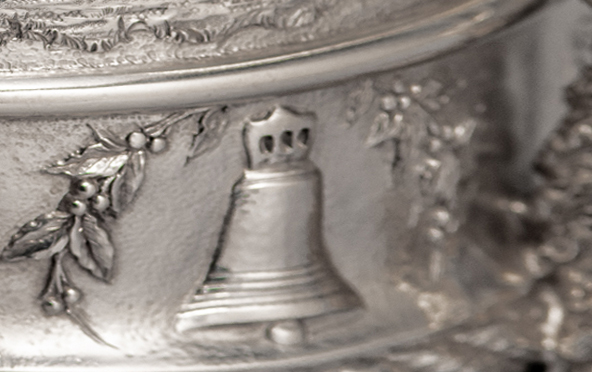
5. Leonard Calvert Monument (number 42)
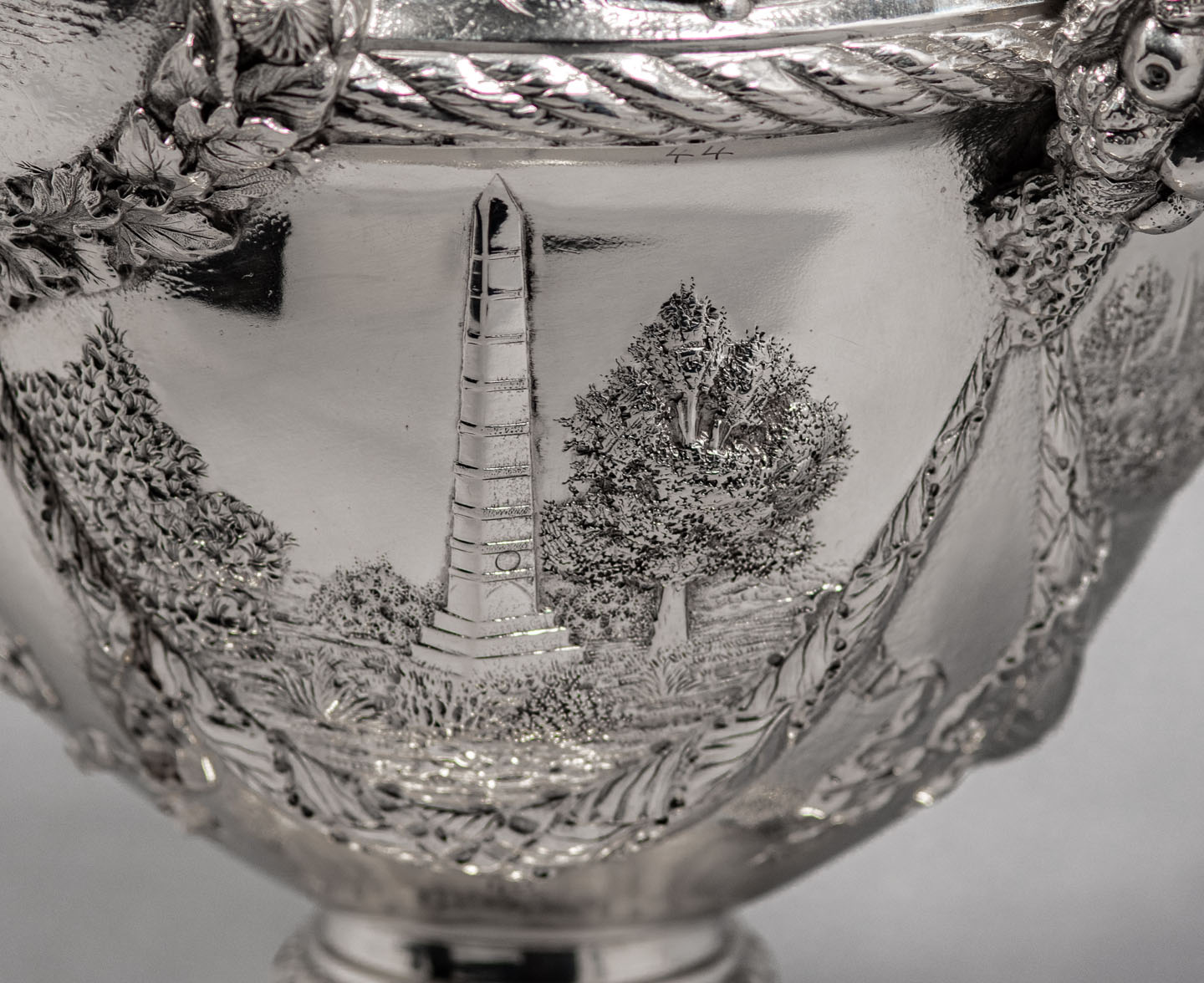
|
This web site is presented for reference purposes under the doctrine of fair use. When this material is used, in whole or in part, proper citation and credit must be attributed to the Maryland State Archives. PLEASE NOTE: The site may contain material from other sources which may be under copyright. Rights assessment, and full originating source citation, is the responsibility of the user. |
© Copyright August 07, 2024 Maryland State Archives
